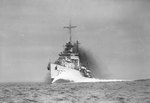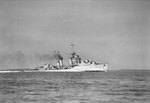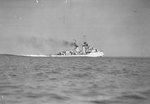Drayton
| Country | United States |
| Ship Class | Mahan-class Destroyer |
| Builder | Bath Iron Works Corporation, Bath, Maine, United States |
| Laid Down | 20 Mar 1934 |
| Launched | 26 Mar 1936 |
| Commissioned | 1 Sep 1936 |
| Decommissioned | 9 Oct 1945 |
| Displacement | 1,500 tons standard |
| Length | 341 feet |
| Beam | 35 feet |
| Draft | 10 feet |
| Speed | 37 knots |
| Crew | 158 |
| Armament | 5x5in guns, 12x21in torpedo tubes |
Contributor: C. Peter Chen
ww2dbaseAfter Drayton's shakedown cruise to Europe from 6 Oct to 5 Dec 1936, she Drayton underwent final trials and acceptance, then sailed from Norfolk, Virginia, United States on 6 Jun 1937 to join the Scouting Force at San Diego, California on 19 Jun. On 4 Jul, she got underway to take part in the fruitless search for the lost aviator Amelia Earhart. She returned to San Diego 30 Jul. She served off the west coast of the United States, Hawaii, and in the Caribbean Sea for the next two years. On 12 Oct 1939, she was assigned to base in Pearl Harbor, where she operated out of through the start of the Pacific War.
ww2dbaseWhen the Japanese struck Pearl Harbor in Dec 1941, she at sea with carrier Lexington; she returned to Pearl Harbor on 13 Dec after spending a few days searching for the Japanese fleet. Between 24 Dec 1941 and 7 Jan 1942, she escorted a convoy to Christmas Island, making two attacks on submarines en route. On 11 Jan, she sailed with Lexington as escort for Lexington’s mission to strike Japanese facilities on Rabaul, which was aborted following the action off Bougainville on 20 Feb; she returned to Pearl Harbor on 24 Feb. After escorting a tanker to Suva Harbor, Fiji, she sailed for the United States, arriving at San Diego on 5 Apr, and performed training exercises and patrol duties until 1 Aug 1942.
ww2dbaseReturning to Pearl Harbor in Aug 1942, Drayton sailed for the Solomon Islands on 17 Nov. On 29 Nov, she sailed with Task Force 67 to intercept Japanese transports en route to Guadalcanal, and came across them on the night of 30 Nov. In the action that later came to be known as the Battle of Tassafaronga, she fired two torpedoes at 2307, while her fellow destroyer Perkins fired eight, followed up by gunfire, which surprised the Japanese convoy. At the end of the action, this battle set up by the Americans turned out to be a humiliation (thought that would not be realized until after the war) as the Japanese convoy succeeded in their primary mission after heavily damaging the American task force. Drayton rescued 128 survivors of the sinking cruiser Northampton and returned to Espiritu Santo on 2 Dec. She remained in the Solomon Islands until Mar 1943 and performed a range of missions ranging from the bombardment of Munda, New Georgia to escorting transports for the Russell Islands.
ww2dbaseSailing from NoumÈa on 13 May 1943, Drayton escorted a transport convoy to Townsville, Australia. Through summer 1943, she escorted many transport missions between Australia and Milne Bay, New Guinea and provided gunfire support on against Japanese positions at Lae on 4 Sep and at Finschhafen on 22 Sep. After a brief overhaul Brisbane, Australia, she escorted transports to Arawe, New Britain on 15 Dec 1943. On 26 Dec, she covered US Marine landings near Cape Gloucester, New Britain. On 2 Jan 1944, she escorted transports from Buna to attack Saidor, both on New Guinea. After brief replenishment at Sydney, Australia, she patrolled the Bismarck Archipelago for the following month.
ww2dbaseIn Feb 1944, Drayton carried troops to Los Negros Island of the Admiralty Islands for the invasion, then remained there to provide gunfire support. On 4 Mar, she carried reinforcements from Milne Bay to Los Negros. On 12 Mar, she bombarded Pityilu Island then sailed with LST ships for Seadler Harbor, Manus Island, both in the Admiralty Islands. She sailed to New Guinea, then escorted transports from Milne Bay to Canton Island of the Phoenix Islands. From Canton Island, she sailed for the west coast of the United States, arriving at San Francisco, California for an overhaul.
ww2dbaseAfter the overhaul, Drayton held training exercises off Pearl Harbor. She returned to the South Pacific on 8 Aug 1944 to patrol the Japanese garrisons in the Marshall Islands that had been skipped over in the island hopping campaign. On 20 Oct 1944, she joined the 7th Fleet at Humboldt Bay, New Guinea, and sailed for Leyte Gulf in the Philippine Islands. In the morning of 5 Dec, while screening a convoy of LCM and LCI(L) ships to San Pedro Bay in the Philippine Islands, she was attacked by a twin-engine bomber which scored a near miss, killing two and wounding seven of her crew. About an hour later, she repulsed a group of strafing aircraft. Later in the same morning, she engaged 10 to 12 Japanese fighters; one of them crashed into a 5-inch gun mount, killing six and wounding 12 men. After completing the convoy mission, she sailed unescorted to Manus Island for repairs.
ww2dbaseBetween 9 Jan to and 18 Feb 1945, Drayton provided gunfire support from Lingayen Gulf, Luzon for troop fighting on the ground. She also provided similar support for operations at Mangarin Bay Puerto Princesa, Cebu, Ormoc Bay, and Masbate City. On 23 Apr, she sailed to Borneo to support the campaign there, screening for larger ships at Tarakan from 1 to 27 May and at Balikpapan from 1 to 2 Jul. She returned to Manila on 29 Jul 1945.
ww2dbaseDrayton's final journey took place before the Pacific War ended. On 7 Aug, the day after Hiroshima was devastated by the first atomic bomb, she sailed for the United States from Manila, Luzon, Philippine Islands. She arrived at New York on 12 Sep, and was decommissioned a month later. She was sold for scrap on 20 Dec 1946.
ww2dbaseSource: United States Navy Dictionary of American Naval Fighting Ships.
Last Major Revision: Jun 2007
Destroyer Drayton Interactive Map
Photographs
 |  |  |  |
Drayton Operational Timeline
| 1 Sep 1936 | Drayton was commissioned into service. |
| 20 Feb 1942 | A Japanese H6K flying boat piloted by Lieutenant (jg) Noboru Sakai spotted a US carrier force 460 miles northeast of New Britain; US pilot Jimmy Thatch of Fighting Squadron 3 (VF-3) flying from USS Lexington shot down Sakai's aircraft at 1112 hours, but not before Sakai had alerted others. At 1202 hours, Burt Stanley and Leon Haynes, also of VF-3, shot down another H6K aircraft flown by Warrant Officer Kiyoshi Hayashi north of Lexington. At 1420 hours, 17 Type 1 bombers of Japanese 4th Air Group, led by Lieutenant Masayoshi Nakagawa, were launched from Rabaul, with the first wave reaching Lexington at 1625 hours. The first wave of 9 bombers were all shot down without causing any damage to Lexington (Nakagawa tried to crash into Lexington as he fell from the sky, but fell short by less than 1 mile). US Navy Lieutenant Albert Vorse of VF-3 shot down one of these bombers for his first aerial kill. The second wave attacked USS Lexington and USS Minneapolis at 1705 hours, still causing no damage; Edward "Butch" O'Hare shot down 3 and damaged 4 Japanese bombers. Only 2 Japanese bombers arrived back at Rabaul at the end of the day; 100 Japanese bomber crewmen were lost during the attacks, and Japan also lost 20 men with the H6K reconnaissance flights earlier in the morning. O'Hare was given credit for 5 kills, making him an "Ace in a Day" and leading to him being awarded the Medal of Honor. With the element of surprise lost, Lexington broke off her intended raid on Rabaul. Because of the loss of so many bombers, the Japanese delayed their plans to invade Lae, New Guinea. |
| 2 Jan 1943 | Cruisers USS Nashville, USS St. Louis, USS Helena, USS Honolulu, HMNZS Achilles, USS Columbia, and USS Louisville escorted by destroyers USS Fletcher, USS Nicholas, USS O’Bannon, USS Lamson, and USS Drayton departed Espiritu Santo, New Hebrides on a patrol south of Guadalcanal, Solomon Islands. |
| 8 Jan 1943 | Cruisers USS Nashville, USS St. Louis, USS Helena, USS Honolulu, HMNZS Achilles, USS Columbia, and USS Louisville escorted by destroyers USS Fletcher, USS Nicholas, USS O’Bannon, USS Lamson, and USS Drayton returned to Espiritu Santo, New Hebrides. |
| 9 Oct 1945 | Drayton was decommissioned from service. |
Please consider supporting us on Patreon. Even $1 per month will go a long way! Thank you. Please help us spread the word: Stay updated with WW2DB: |
Visitor Submitted Comments
22 Feb 2021 03:31:18 PM
My Dad was on the Drayton 1st class gunners mate. I remember him talking about the Marshal islands.
All visitor submitted comments are opinions of those making the submissions and do not reflect views of WW2DB.

» Action off Bougainville
» Guadalcanal Campaign
» Solomon Islands Campaign
» New Guinea-Papua Campaign, Phase 3
» Philippines Campaign, Phase 1, the Leyte Campaign
» Philippines Campaign, Phase 2
» Borneo Campaign
- » 1,176 biographies
- » 337 events
- » 44,933 timeline entries
- » 1,245 ships
- » 350 aircraft models
- » 207 vehicle models
- » 376 weapon models
- » 123 historical documents
- » 261 facilities
- » 470 book reviews
- » 28,471 photos
- » 365 maps
Lt. Gen. Lewis B. "Chesty" Puller, at Guadalcanal
Please consider supporting us on Patreon. Even $1 a month will go a long way. Thank you!
Or, please support us by purchasing some WW2DB merchandise at TeeSpring, Thank you!
11 Nov 2018 11:12:46 AM
My dad was a crew member 1944-45, maybe earlier "Robert "Guy" Chambers, he talked very little about his tour in the Navy.